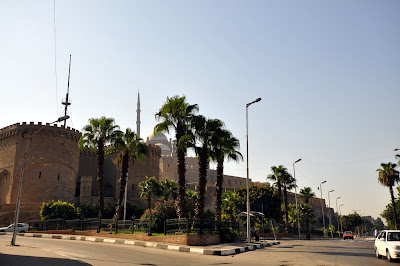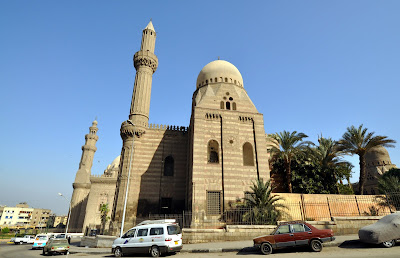Souk Manshiya::the heart of Alexandria
Nostalgic CAIRO:: Intro::our Lifetime adventure
Map 1::the green shaded area marks the Nostalgic historic Cairo and the red dotted line shows the route of our adventure
Walking through the 3 kilometers spinal cord of the nostalgic historical Cairo was really an amazing adventure and experience. This is where the greatest concentration of Islamic features – buildings, tombs, schools, masjids, etc., both in quality and quantity built by prominent in the seventeenth and eighteenth centuries. Egypt must be proud of the inclusion of this historical spot in UNESCO’s World Heritage List. The main intention of the adventure was to have, as much as possible, a close encounters to the features. Sabil-kuttab, for example, is one of its kinds – unique to Cairo, a two storey building with covered water fountain to serve the community on the ground floor and a room for children learning reciting the holy Qur’an at the upper level. Another feature is the wikalas – akin to hostel which has small living units in the upper level and commercial uses at ground floor. 
Photo: Bab al Azab of the Salah al Din Citadel. Part of the domes of the Masjid Muhammad Ali can be seen in the background
The historic Cairo comprises of the ‘Old Cairo’ or the origin of Cairo, referring to al Fustat – the first Islamic settlement in Egypt, perhaps is Africa, established by one of the prominent Companion of Prophet Muhammad saw (peace be upon him), ‘Amr ibn al ‘As, sent by the second Caliph of Islam, Umar ra in 632; the Citadel – which dominates the urban fabric of the city and crucial to the structure of historic Cairo; the historic city, which covers the Fatimid city; Bulaq and last but not least, the historic Islamic cemeteries. 

Photo: The south side of Masjid Mahmud Pasha. On the right hand side is the dome of Masjid Amir Akhur and on the left, is part of Masjid & Madrasah Sultan Hassan
Our three and a half hours adventure, however, covered only the spine of the historic city from the popular Sultan Hassan Masjid cum madrasah or religious school at the foothill of the Citadel to the al Hakim bi ‘Amrullah Masjid on the north side of the Fatimid city. 
Photo: The west side of the Masjid Amir Akhur
We approached our adventure from the south side of the city, where cluster of Masjids – Masjid Sultan Hassan; Masjid ar Rafai’e; Masjid Mahmud Pasha and Masjid Amir Akhur found right at the foothill of the majestic Citadel.
Arrived and parked our car in front of Bab al Azab of the Citadel (facing the south-west side of Masjid Mahmud Pasha) at 09:02 hours, from where I walked to the beautifully landscaped round about to shoot the panoramic scene of this cluster. My NIKKOR wide-angle lens had helped me to capture these magnificently crafted buildings.
ESNCairo2::Shrine of Qansuh Sa'id
Photo below: Qansuh Sa'id's shrine. Sad to mention, the condition is a bit run down.
Photo below: the Dar el Mahfouzate Masriya part of the Salah al Din Citadel's features.
ESNCairo3::Masjid Aytmish el Bagasi and Tarabay as Sharifi's Shrine
Around the Mosque appears a group of buildings with its unique features - the mashrabiyas, that date from Mohamed Ali period.
Mashrabiya literally means drinking place, and the term was used because porous earthenware jugs were placed near the latticed windows so that the incoming air would be cooled by the evaporation. During the Mamluk time, mashrabiyas were used as screens, partitions, and windows, providing gentle light, cool air, and privacy.
 To the right of the façade is Bab al Turba Street, which led us to the Bab al Tarabay al Sharifi built and established by Prince Tarabay in 1504. He was commander of the army of Mamluks under Sultan al Ghuri. On the right hand side of the gate, is the sabil-kuttab (photo above) that once led to a madrasah. 3 meters after the gate, on the left hand side is the shrine of Tarabay al Sharifi (photo below). The façade of the shrine, a large domed cube.
To the right of the façade is Bab al Turba Street, which led us to the Bab al Tarabay al Sharifi built and established by Prince Tarabay in 1504. He was commander of the army of Mamluks under Sultan al Ghuri. On the right hand side of the gate, is the sabil-kuttab (photo above) that once led to a madrasah. 3 meters after the gate, on the left hand side is the shrine of Tarabay al Sharifi (photo below). The façade of the shrine, a large domed cube.
 I spent 5 minutes on the eastern side of the monument and planned to shoot the whole features, but was stopped by a man. “Masalamah”, I responded to him politely and continued back my adventure through Bab al Wazir Street to another cluster of building towards the north of the street. On the way out, there were few old women with their children (I presume) - street vendors selling local produce to survive the harsh life.
I spent 5 minutes on the eastern side of the monument and planned to shoot the whole features, but was stopped by a man. “Masalamah”, I responded to him politely and continued back my adventure through Bab al Wazir Street to another cluster of building towards the north of the street. On the way out, there were few old women with their children (I presume) - street vendors selling local produce to survive the harsh life.
ESNCairo4::Palace Alin Aq & Masjid Amir Khayr Bek
In the photo below, is the view of the Masjid of Amir Khayr Bek from the west side of the Palace of Alin Aq. You could also see the top structure of the Palace and some restoration work is still in slow progress.
It is said that Amir Khayr Bek betrayed his master Sultan al Ghuri and defected the Ottomans at the decisive battle near Aleppo or Halab, Syria in 1516, opening the door to conquest of Egypt. Hence, he was made the first viceroy of the Ottomans in Egypt. The shrine was built in 1502, while the masjid attached to it date from 1520, making the transition between the Mamluk and the Ottoman periods.
ESNCairo5::Masjid & Madrasah Umm Sultan Sha'aban
ESNCairo6::House of Ahmad Katkhuda al Razzaz
ESNCairo7::Zawiyat 'Arif Pasha
ESNCairo8::Tomb of Abu al Yusufayn
ESNCairo9::Masjid Atinbugha Maridani
Subscribe to:
Posts (Atom)

